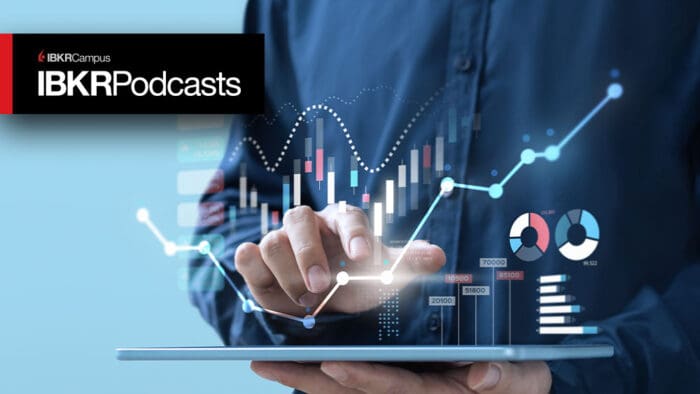With all eyes on the Fed’s Wednesday announcement, Neil Azous is looking at the prospect of one particular recession indicator to start the race to interest rate cuts before the end of 2023. The Sahm recession indicator considers the 12-month low for the national unemployment rate relative to a rise in the three-month average rate. The Sahm recession indicator is already flashing red in California, home to 50-million Americans and 15% of national GDP. Will the same ring true for the national economy following the July employment report? Neil hints that it will.
Sponsor Information:
Email: nazous@rareviewcapital.com
Note: Any performance figures mentioned in this podcast are as of the date of recording (June 9, 2023).
Summary – IBKR Podcasts Ep. 82
The following is a summary of a live audio recording and may contain errors in spelling or grammar. Although IBKR has edited for clarity no material changes have been made.
Andrew Wilkinson
Welcome to another IBKR podcast. This is Andrew Wilkinson. I’m your host here. This week’s guest is Rareview Capital’s Chief Investment Officer, Neil Azous. Welcome, Neil.
Neil Azous
Thank you, Andrew, for having me always great to be with you ahead of these significant market events such as the Federal Reserve meeting next week.
Andrew Wilkinson
Well folks, I like to bring Neil onto these podcasts specifically, as he says, ahead of the FOMC meetings, because he’s got an excellent handle on all things concerning monetary policy. Tell us a little bit about what the monetary policy actions at the Reserve Bank of Australia and the Canadian Central Bank recently might have on the outlook from the FOMC.
Neil Azous
So why don’t I just break that up into two parts? The first one regarding the outlook going into the FOMC meeting, and then I’ll address the Reserve Bank of Australia and the Bank of Canada. So, I always answer that question first by analyzing what the markets pricing regarding the path of interest rate policy here. And we do that in probabilistic terms or probabilistic outcomes. So, currently the bond market is pricing in a 27% chance of a 25-basis point hike at the June 14th meeting next week, and a 53% chance of a 25-basis point hike at the July 26th meeting. So, cumulatively that is an 80% chance of one 25-basis point hike by the July meeting. The bond market is just saying that the Fed is going to skip raising interest rates next week, but they’re going to raise the interest rate by 1/4 percent at the July meeting. And of course, when we’re armed with that information, we always have to ask what are the potential asymmetric outcomes based on that market pricing at the moment. There are three scenarios where the market could be the most caught off guard. Firstly, if the Fed were to raise interest rates by 1/4 percent at next week’s meeting: That would be an issue. Currently there’s just a 25% chance of that outcome. That’s the equivalent of one-in-four-chance.
The second asymmetric outcome would be, on next Tuesday, prior to the Wednesday Fed meeting, the US inflation data is released. If it is softer than expected and the bond market reduces the odds of a hike at the July meeting, that would also probably pull forward interest rate cuts from next year into this year. So, that would be a surprise factor.
And the third and final one is if the Fed skips June, or next week, raising interest rates and they realized that was a mistake after another round of strong economic data in July, and they signaled to the market that they have to play catch up and the market starts to put a half a percent hike on the table for the July meeting. So those would be the three asymmetric outcomes where market agents would be caught off guard.
Regarding the question of the potential impact of the surprise rate hikes in Australia and Canada over the last two weeks, I would just phrase it this way. Optically, it’s a surprise and it definitely warrants conversation. But most of that conversation is subjective in nature, meaning the probabilities for next week’s Fed meeting, or even the probabilities for the July meeting did not change much. And also, the impact to the yield curve, just keeping things very generic, looking at the the US Treasury 2-year to 10-year yield curve, it is largely in the same place as where it was last Friday. So right now, we’re mindful of it, but I think the market is taking the view in actual pricing that those banks have more wood to chop, and they started at a later date than the Federal Reserve started hiking interest rates. And they certainly didn’t raise rates at the pace the Fed did. So, the market is, I would say, okay with it at the moment, but they’re mindful that there are surprise factors out there.
Andrew Wilkinson
OK, that covers all the bases. Let’s get on to the labor market. We know that monetary policy works with a lag. So, we’ve had a significant tightening over the last year and a bit. Employment gains though have continued at a breakneck pace. How are you seeing the labor market at this point?
Neil Azous
The labor market is still firm, but it seems soft enough for a pause next week. Another way to characterize the labor market is to say that it’s healthy on an absolute basis, but it’s deteriorating under the surface, albeit at a slow pace. And let me give you two examples or the two main talking points regarding that slow deterioration. So first, economists like to track this metric called Weekly Hours Worked and they use that as a leading indicator. And the argument is that once a company cuts back on employee hours the next step is to just lay them off. And the the current decline in weekly hours worked is pretty large at the moment, and it’s definitely on par with other recessionary readings or even ahead of most other recession.
The next step is really for the initial jobless claims or job openings data to confirm what you’re seeing in the weekly hours worked [series] deterioration and we saw that yesterday. The initial jobless claims made a new 18 month high. Said differently, if you charted jobless claims like a stock, it looks like it just hit an acceleration point and the stock started to break out of a long-term range. So, the second example is the unemployment rate. And while still low on an absolute basis, it is back to the highest level over the last 18 months. And what everyone’s going to look for in early July when we get that next monthly US employment data report is whether the Sahm recession indicator is triggered, and I’ll just explain that real quickly. The Sahm recession indicator signals the start of a recession historically. That occurs when the three-month moving average of the national unemployment rate rises by a half percent or more relative to its low of the prior year. Nationally, the low of the unemployment rate was 3.4% in April. And the high was 3.7% just last May, a month ago, so another 0.2% higher. And definitely the Bears will be out in full force and and they’ll be saying hey, the Sahm recession indicator has been triggered. For now, I would just say there’s a head start. California, which is, as you know, is 15% of US GDP and 50 million people, is a notable standout, where their unemployment rate is 0.7% above its August 2022 low. So, in California terms, that Sahm recession indicator has already been triggered. The combination of these things are showing that slow deterioration under the market, despite the absolute level still remaining in a robust or healthy manner.
Andrew Wilkinson
At the start of the year, Neil, you elaborated on how the money market was discounting significant monetary policy easing even before the Fed had finished raising interest rates. So how does the buoyancy of the economy currently shape your view about policy going forward?
Neil Azous
Frankly, Andrew, nothing material has changed outside of inflation continuing to come down. That said, we remain most interested in historical precedents, and here are the facts. On average, the Fed has cut an interest rate 6 1/2 months after the last interest rate hike: The shortest it has been is 1.4 [months], and the longest it’s been is 14.7 months, and notably the Fed does cut an interest rate 2.4 times faster than they hike on average. So, if May (or last month) was indeed the last interest rate hike, and the average precedent holds true again, the Fed should cut the Fed funds rate by December and that’s what’s priced into the market. So, while all these other things are going on in the background, the historical precedents are still being priced. The facts are the facts and and not a whole lot of things have changed except inflation coming down.
Andrew Wilkinson
So now looking in the rearview mirror a little bit here, the Fed was forced to add liquidity on account of the recent banking crisis, was that February, March time? Some commentators are pointing to an overall reduction in liquidity taking place as the the FOMC tidies up its balance sheet. Is there any truth to that? And should equity investors particularly be concerned?
Neil Azous
Let me provide some context briefly for those who are not familiar with this concept leading up to the debt ceiling passage. The Treasury General Account, AKA the TGA, was drawn down close to zero and now the US Treasury needs to issue a larger amount of new T-bills to help replenish that account, and someone has to absorb that new bond market issuance. So, on the margin, that is a tighter liquidity condition because funds who used to buy T-bills can’t buy riskier assets. And if you add in the Fed’s quantitative tightening program (or QT) or you move over to Europe and look at the European Central Bank’s equivalent programs, which is called the TLTRO, and there’s probably a total of somewhere between one to one-and-a-half trillion dollars of, quote-unquote, perceived tightening of liquidity. Therefore, the Bears say the summer will be treacherous for stocks. That’s the general background or the context of this concept to me, Andrew. This is just the Bears trying to meet their quota for the Disease of the Month Club. First it was the US regional banking crisis. Then, it was the US debt ceiling crisis, and now it’s a liquidity crisis. Someday, someone’s going to have to explain to me, Andrew, the plumbing that drains the equity market, liquidity from the Treasury general account. And until that happens, for me, it’s just investment mythology. Yeah, similar to gold as an inflation hedge. And all I know is despite all these liquidity concerns or the regional bank concerns or the debt ceiling concerns or whatever the disease of the month, is that the stock market made a new high this morning.
Andrew Wilkinson
Well, let’s wrap this up with one last question. And this is really for my edification here. I’m having a hard time believing that interest rates will officially be lower by the end of the year unless there’s some catastrophe that we’re not prepared for. What am I missing Neil?
Neil Azous
I appreciate that question, and I’m definitely mindful of the quote-unquote higher for longer view. That said, Andrew, here’s how I reconcile it. As I highlighted earlier, I just start with the historical precedent of facts and from there I make bets on probabilistic outcomes. By baseline, as I said earlier, is that on average the Fed cuts interest rates 6 1/2 months after the last interest rate hike and if May was the last hike, we know we should be cutting by December on average. So, that answers the question of, can the Fed cut interest rates by year end? So, the answer there is yes. And then secondly, the pace of upcoming disinflationary impulses I think is likely going to surprise market professionals. Most of our models and our leading indicators argue that US core CPI is going to be near 3% by December and maybe even drop at or below the Fed’s target in early 2024. So here’s a basic list Andrew. If you look at the New York Fed’s global supply chain pressure index, it has not only returned to pre pandemic levels, but it’s also now squarely in a deflationary territory on an index. That’s another way of saying that there are no longer supply chain issues. The benchmark for commodities is down 30 to 40%, so the the input cost pressures that we saw before related to the Ukraine-Russia war in terms of the breakfast cereals like wheat and grains and things like, all prices are down 30 to 40%, so you just have to look at any commodities to see that you’ve lost money. Indicators such as wage pressures have started to come down. If you look at ISM prices paid either the components plunging and the truck levels, they’re consistent with the 2% CPI target now. And as I’m saying, leading indicators of inflation such as the ISM business prices or the NFIB Small Businesses planning to increase prices, those [indices] have also come down dramatically, so those both work on six-month lags and suggest core CPI also at 3% by December. So, this disinflation isn’t only in commodities, goods or services now, we’re seeing these inflationary pressures abate in housing, rent and things like that. So, the the list could go on. But overall, I believe that the markets are far from fully appreciating this major or accelerating disinflationary impulse, which really brings important implications for portfolio construction. So, to answer your question, Andrew, it is the historical precedent. And the Fed, winning on their inflation mandate that helps you get around the idea that they can’t cut an interest rate in line with historical precedents.
Andrew Wilkinson
My guest has been Neil Azous, CIO and founder at Rareview Capital. Neil, a huge thanks for joining me to create this edition.
Neil Azous
My pleasure. Thank you, Andrew.
Andrew Wilkinson
And folks, if you enjoyed today’s edition, please do leave us a review wherever you download your podcasts from. Thanks for joining us.
Join The Conversation
For specific platform feedback and suggestions, please submit it directly to our team using these instructions.
If you have an account-specific question or concern, please reach out to Client Services.
We encourage you to look through our FAQs before posting. Your question may already be covered!
Leave a Reply
Disclosure: Interactive Brokers
The analysis in this material is provided for information only and is not and should not be construed as an offer to sell or the solicitation of an offer to buy any security. To the extent that this material discusses general market activity, industry or sector trends or other broad-based economic or political conditions, it should not be construed as research or investment advice. To the extent that it includes references to specific securities, commodities, currencies, or other instruments, those references do not constitute a recommendation by IBKR to buy, sell or hold such investments. This material does not and is not intended to take into account the particular financial conditions, investment objectives or requirements of individual customers. Before acting on this material, you should consider whether it is suitable for your particular circumstances and, as necessary, seek professional advice.
The views and opinions expressed herein are those of the author and do not necessarily reflect the views of Interactive Brokers, its affiliates, or its employees.















UNSUBSCRIBE NOW
Hello Gary, to unsubscribe from our newsletter(s), please visit this webpage: http://spr.ly/IBKR_Unsubscribe. If you change your mind, you can always re-subscribe on our IBKR Campus website (https://ndcdyn.interactivebrokers.com/IBSales/IBKRCampus).